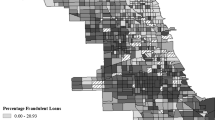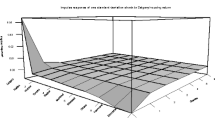Abstract
We analyze the spatial default dependence between pairs of nonconforming securitized mortgages, originated in Los Angeles between 2000 and 2011 and clustered by zip code. Our approach allows us to estimate the range and shape of the spatial dependence function, which relates zip-code center-to-center distance between mortgages to the dependence parameter of a number of different copulas. We find significant evidence for the presence of spatial dependence, which decays to zero within 40km and can be well characterized by a squared exponential function, a special case of the Matérn spatial correlation function.



Similar content being viewed by others
Notes
This obtains by total differentiation of \(\phi \left (C(\bar {\pi }_{1},\bar {\pi }_{2};\theta )\right )=\phi (\bar {\pi }_{1};\theta )+\phi (\bar {\pi }_{2};\theta )\) with respect to 𝜃.
References
Anenberg, E., & Kung, E. (2014). Estimates of the size and source of price declines due to nearby foreclosures. American Economic Review, 104(8), 2527–51.
Ashcraft, A., Goldsmith-Pinkham, P., Vickery, J. (2010). MBS ratings and the mortgage credit boom. Tech. rep., Federal Reserve Bank of New York.
Bai, Y. (2011). Joint composite estimating functions in spatial and spatio-temporal models. PhD thesis, University of Michigan.
Bai, Y., Song, P.X.K., Raghunathan, T.E. (2012). Joint composite estimating functions in spatiotemporal models. Journal of the Royal Statistical Society B, 75(5), 799–824.
Bai, Y., Kang, J., Song, P.X.K. (2014). Efficient pairwise composite likelihood estimation for spatial-clustered data. Biometrics, 70(3), 661–670.
Bourassa, S.C., Cantoni, E., Hoesli, M. (2007). Spatial dependence, housing submarkets and house price prediction. Journal of Real Estate Finance Economics, 35(2), 143–160.
Campbell, J.Y., Giglio, S., Pathak, P. (2011). Forced sales and house prices. American Economic Review, 101(5), 2108–2131.
Case, B., Clapp, J., Dubin, R., Rodriguez, M. (2004). Modelling spatial and temporal house price patterns: a comparison of four models. Journal of Real Estate Finance and Economics, 29(2), 167–191.
Clapp, J.M., Goldberg, G.M., Harding, J.P., LaCour-Little, M. (2001). Movers and shuckers: interdependent prepayment decisions. Real Estate Economics, 29(3), 411–450.
Clapp, J.M., Deng, Y., An, X. (2006). Unobserved heterogeneity in models of competing mortgage termination risks. Real Estate Economics, 34(2), 243–273.
Das, S.R., Duffie, D., Kapadia, N., Saita, L. (2007). Common failings: how corporate defaults are correlated. Journal of Finance, 62(1), 93–117.
Demyanyk, Y., & Van Hemert, O. (2011). Understanding the subprime mortgage crisis. Review of Financial Studies, 24(6), 1848–1880.
Deng, Y., Pavlov, A.D., Yang, L. (2005). Spatial heterogeneity in mortgage terminations by refinance, sale and default. Real Estate Economics, 33(4), 739–764.
Dubin, R. (1998). Predicting house prices using multiple listings data. Journal of Real Estate Finance and Economics, 17(1), 35–59.
Duffee, G. (1999). Estimating the price of default risk. Review of Financial Studies, 12(1), 197–226.
Duffie, D, & Singleton, KJ. (2003). Credit risk. Princeton Series in Finance.
Genest, C., Nikoloulopoulos, A.K., Rivest, L.P., Fortin, M. (2013). Predicting dependent binary outcomes through logistic regressions and meta-elliptical copulas. Brazilian Journal of Probability and Statistics, 27(3), 265–284.
Gneiting, T., Kleiber, W., Schlather, M. (2010). Matérn cross-covariance functions for multivariate random fields. Journal of the American Statistical Association, 105(491), 1167–1177.
Goorah, A. (2007). Real estate risk management with copulas. Journal of Property Research, 24(4), 289–311.
Guiso, L., Sapienza, P., Zingales, L. (2013). The determinants of attitudes toward strategic default on mortgages. Journal of Finance, 68(4), 1473–1515.
Harding, J.P., Rosenblatt, E., Yao, V.W. (2009). The contagion effect of foreclosed properties. Journal of Urban Economics, 66(3), 164–178.
Joe, H. (2005). Asymptotic efficiency of the two-stage estimation method for copula-based models. Journal of Multivariate Analysis, 94(2), 401–419.
Kau, J.B., Keenan, D.C., Muller, I.I.I.W.J., Epperson, J.F. (1992). A generalized valuation model for fixed-rate residential mortgages. Journal of Money, Credit and Banking, 24(3), 279–299.
Kau, J.B., Keenan, D.C., Kim, T. (1993). Transaction costs, suboptimal termination and default probabilities. Journal of the American Real Estate and Urban Economics Association, 21(3), 247–263.
Kau, J.B., Keenan, D.C., Lyubimov, C., Slawson, C.V. (2011). Subprime mortgage default. Journal of Urban Economics, 70(2/3), 75–87.
Kazianka, H. (2013). spatialcopula: a matlab toolbox for copula-based spatial analysis. Stochastic Environmental Research and Risk Assessment, 27(1), 121–135.
Keys, B.J., Mukherjee, T., Seru, A., Vig, V. (2010). Did securitization lead to lax screening? Evidence from subprime loans. The Quarterly Journal of Economics, 125(1), 307–362.
Li, Y., & Lin, X. (2006). Semiparametric normal transformation models for spatially correlated survival data. Journal of the American Statistics Association, 101, 591–603.
Liu, X. (2012). Survival analysis: models and applications. New York: Wiley.
Manski, C. (1995). Identification problems in the social sciences. Cambridge: Harvard University Press.
Mayer, C., Pence, K., Sherlund, S.M. (2009). The rise in mortgage defaults. The Journal of Economic Perspectives, 23(1), 27–50.
Mian, A., & Sufi, A. (2009). The consequences of mortgage credit expansion: evidence from the U.S. mortgage default crisis. Quarterly Journal of Economics, 124 (4), 1449–1496.
Paik, J., & Ying, Z. (2012). A composite likelihood approach for spatially correlated survival data. Computational Statistics and Data Analysis, 56(1), 209–216.
Patton, A.J. (2009). Copula-based models for financial time series. In T.G. Andersen, R.A. Davis, J.-P. Kreiss, T.V. Mikosch (Eds.) Handbook of financial time series. Berlin: Springer.
Rajan, U., Seru, A., Vig, V. (2015). The failure of models that predict failure: distance, incentives, and defaults. Journal of Financial Economics, 115(2), 237–260.
Rasmussen, C.E., & Williams, C.K. (2006). Gaussian processes for machine learning. The MIT Press.
Sherlund, S. (2010). The past, present, and future of subprime mortgages. In R.W. Kolb (Ed.) Lessons from the financial crisis: causes, consequences and our economic future (pp. 147–154): Wiley.
Sklar, A. (1959). Fonctions de répartition à n dimensions et leurs marges. Pub Inst Statist Univ Paris, 8, 229–231.
Sueyoshi, G.T. (1995). A class of binary response models for grouped duration data. Journal of Applied Econometrics, 10(4), 411–431.
Towe, C., & Lawley, C. (2013). The contagion effect of neighboring foreclosures. American Economic Journal: Economic Policy, 5(2), 313–335.
Varin, C. (2008). On composite marginal likelihoods. Advances in Statistical Analysis, 92, 1–28.
Varin, C., & Vidoni, P. (2005). A note on composite likelihood inference and model selection. Computational Statistics and Data Analysis, 92(3), 519–528.
Varin, C., Reid, N., Firth, D. (2011). An overview of composite likelihood methods. Statistica Sinica, 21(1), 5–42.
Voicu, I., Jacob, M., Rengert, K., Fang, I. (2012). Subprime loan default resolutions: do they vary across mortgage products and borrower demographic groups? Journal of Real Estate Finance and Economics, 45(4), 939–964.
Zimmer, D.M. (2012). The role of copulas in the housing crisis. Review of Economics and Statistics, 94(2), 607–620.
Zimmer, D.M. (2015a). Analyzing comovements in housing prices using vine copulas. Economic Inquiry, 53(2), 1156–1169.
Zimmer, D.M. (2015b). Time-varying correlation in housing prices. Journal of Real Estate Finance and Economics, 51(1), 86–100.
Acknowledgments
The authors gratefully acknowledge the support of the QUANTVALLEY/FdR: Quantitative Management Initiative. This research has been conducted as part of the Labex project MME-DII (ANR11-LBX-0023-01) and of the ANR project BREAKRISK. We thank participants at the Financial Risks International Forum, Paris, March 2014, the Augustin Cournot Doctoral Days, Strasbourg, April 2014, the International conference of the American Real Estate and Urban Economics Association, Reading, July 2014, the Econometric Society European Meeting, Toulouse, August 2014, the Quantitative Management Initiative, Paris Dauphine, November 2014, the INFINITI conference, Ljubljana, June 2015, seminar participants at the University of Laval, January 2015 and the Advances in Time Series and Forecasting workshop at ESSEC, November 2015. We also gratefully acknowledge support from the CDC (Centre De Calcul de l’Université de Cergy-Pontoise) computing center at the University of Cergy-Pontoise. We are indebted to Luc Bauwens and Olivier Scaillet for their helpful comments on earlier versions of this paper. The usual disclaimers apply.
Author information
Authors and Affiliations
Corresponding author
Additional information
Publisher’s Note
Springer Nature remains neutral with regard to jurisdictional claims in published maps and institutional affiliations.
Appendix: Loglikelihood, Score and Hessian
Appendix: Loglikelihood, Score and Hessian
This appendix develops the loglikelihood function, score and Hessian for the pairwise likelihood estimation of the bivariate default probability with copula. Define Yi, i = 1, 2 to be Bernoulli variables with probability πi of default for mortgage i, and \(C(\bar {\pi }_{1},\bar {\pi }_{2};\theta )\) the copula for joint default, where \(\bar {\pi }_{i}=1-{\pi }_{i}\). The loglikelihood is the sum of the contributions of all four possible outcomes:
where we leave out the arguments \((\bar {\pi }_{1},\bar {\pi }_{2};\theta )\) and write \(C \equiv C(\bar {\pi }_{1},\bar {\pi }_{2};\theta )\). In order to compute standard errors, we need to evaluate the score and Hessian. The score can be written as
where \(C_{\theta }=\frac {\partial C}{\partial \theta }\). Using the chain rule, the Hessian can be written as
where \(C_{\theta \theta }=\frac {\partial ^{2} C}{\partial \theta ^{2}}\). We now provide expressions for C𝜃 and C𝜃𝜃 for each copula.
- a. :
-
Farlie Gumbel Morgenstern (FGM)
All Archimedian copulas such as the Gumbel, Frank and Clayton, can be defined in terms of a generator function ϕ, as follows:
As a result, for all Archimedean copulas, the score and Hessian depend on their generator function:Footnote 1
We now provide expressions for the partial derivatives of the generator ϕ, that are needed for computation of the score and Hessian for each of our remaining copulas.
- b. :
-
Gumbel
- c. :
-
Frank
- d. :
-
Clayton
Rights and permissions
About this article
Cite this article
Heinen, A., Kau, J.B., Keenan, D.C. et al. Spatial Dependence in Subprime Mortgage Defaults. J Real Estate Finan Econ 62, 1–24 (2021). https://doi.org/10.1007/s11146-019-09708-w
Published:
Issue Date:
DOI: https://doi.org/10.1007/s11146-019-09708-w




